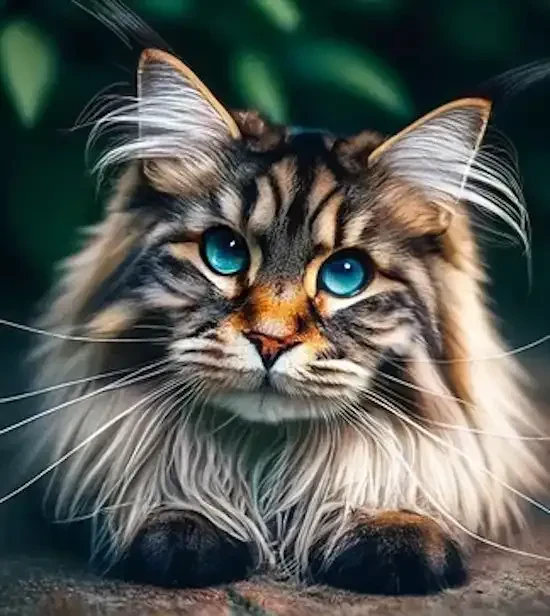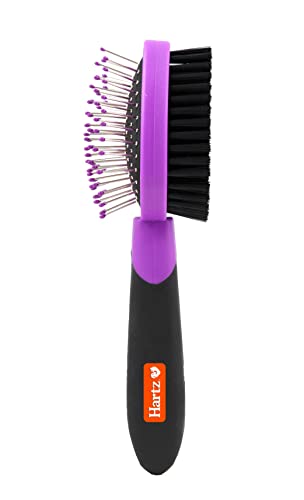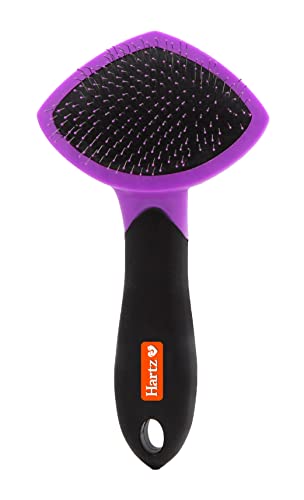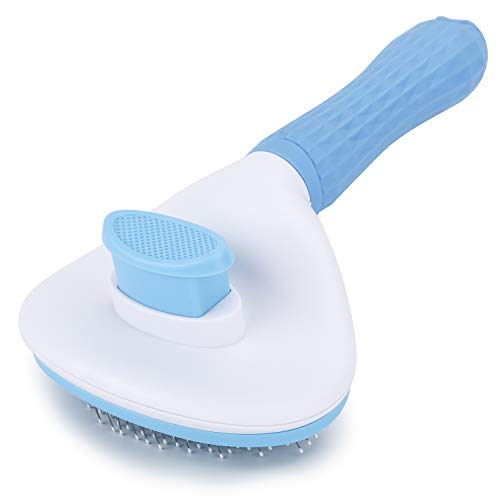"Love your cat, but tired of wearing their fur as a second skin?" It's a sentiment echoed in countless households graced by feline companions. We adore their purrs, their cuddles, their playful antics, but let's be honest – the shedding can be… substantial. Cat hair seems to possess a remarkable ability to infiltrate every corner of our homes, clinging to clothes, furniture, carpets, and seemingly floating in the very air we breathe. While we might joke about it, cat shedding is a very real concern for many cat owners. Beyond the never-ending battle against stray fur tumbleweeds, shedding can trigger allergies in sensitive individuals and contribute to overall household cleanliness challenges. But before you despair and consider living in a giant lint roller bubble, take heart! Cat shedding, while often prolific, is a normal and natural process. The good news is, with the right knowledge and strategies, you can effectively control cat shedding, creating a more comfortable environment for both you and your feline friend. This article is your comprehensive guide to mastering the art of shedding management. We’ll explore the reasons behind shedding, delve into practical home cleaning techniques, uncover the power of grooming, examine the impact of diet, and even address when excessive shedding might signal an underlying health concern. By understanding the intricacies of cat shedding and implementing these effective strategies, you can minimize the fur fallout, maintain a cleaner home, and most importantly, ensure your cat enjoys a healthy and comfortable coat.
To effectively tackle shedding, it’s crucial to first understand the basics of the natural shedding process. Shedding isn't random; it's a carefully orchestrated part of the hair growth cycle. Each hair on your cat's body goes through a continuous cycle of growth, rest, and replacement. This cycle can be broken down into four distinct stages: anagen, catagen, telogen, and exogen. The anagen phase is the active growth phase, where new hair cells are produced and hair length increases. This phase can last for weeks, months, or even years depending on the type of hair and the cat. Following the growth phase is the catagen phase, a transitional phase where hair growth slows down and the hair follicle shrinks. This is a relatively short stage. The telogen phase is the resting phase. Hair growth ceases completely, and the hair follicle is dormant. The hair remains in the follicle but is no longer actively growing. Finally, we reach the exogen phase – the shedding phase. This is when the old hair shaft detaches from the follicle and is pushed out as new hair growth begins in the anagen phase once more. This shed hair is then replaced by a new, growing hair.
But why do cats shed in the first place? Shedding is a fundamental biological process with several important purposes. Primarily, it’s a way for cats to replace old or damaged hair. Just like our skin cells are constantly being replaced, so too are the hairs in a cat’s coat. Shedding ensures that the coat is continually renewed with healthy, functional fur. Shedding also allows cats to adapt to seasonal changes in temperature. Many cats, especially those with outdoor access or those who retain more of their wild ancestors' biological rhythms, exhibit seasonal shedding. They shed their heavier winter coats in the spring as temperatures rise and daylight hours lengthen, preparing for the warmer months. Conversely, they may shed less and grow a thicker coat in the fall as they gear up for winter's chill. Ultimately, shedding is essential for maintaining overall coat health. It allows for the removal of dead hair, preventing matting, tangles, and skin irritation, and promotes healthy new hair growth.
While shedding is normal, it’s important to be able to differentiate between normal and excessive shedding. What constitutes "normal" shedding? Normal shedding levels vary based on several factors, including breed. Long-haired breeds, like Persians and Maine Coons, naturally tend to shed more than short-haired breeds, like Siamese or Bengals. Double-coated breeds, such as Norwegian Forest Cats and Siberian cats, which possess a dense undercoat for insulation, are also typically heavy shedders, particularly during seasonal shedding periods. Season also plays a significant role, as mentioned, with most cats experiencing increased shedding during spring and fall. Individual cats can also have slightly different “normal” shedding levels based on their genetics and overall health. So, how do you recognize excessive shedding? Excessive shedding goes beyond the typical, expected fur loss for your cat. It might manifest as clumps of hair falling out noticeably more than usual, a thinning coat that appears less dense than normal, the appearance of bald patches or areas with significantly reduced hair, or a sudden and dramatic change in your cat's usual shedding patterns. When should you be concerned about shedding? While some fluctuations are normal, significant changes in your cat’s shedding patterns, especially if accompanied by other symptoms, can be a sign of underlying health issues. If you notice a sudden increase in shedding, bald patches, skin irritation, excessive scratching, or changes in your cat’s appetite, energy levels, or behavior, it's important to consult with your veterinarian to rule out any medical causes.
Several factors can influence the amount and type of shedding your cat experiences. Breed, as we’ve discussed, is a primary determinant, with genetics playing a major role in coat type and shedding propensity. Seasonality is another key influence, with the changing seasons triggering natural shedding cycles. Diet and nutrition are also fundamental. A high-quality diet, rich in protein, essential fatty acids (Omega-3 and Omega-6), vitamins, and minerals, is crucial for maintaining a healthy coat. Nutrient deficiencies can lead to dry, brittle fur and increased shedding. Underlying health conditions can also significantly impact shedding. Excessive shedding can be a symptom of various medical issues, including allergies (food or environmental), parasitic infestations (fleas, mites), skin infections (bacterial or fungal), hormonal imbalances (hyperthyroidism), stress, and even systemic illnesses. Finally, grooming habits, or rather, a lack thereof, directly affect shedding levels. Regular grooming helps remove loose fur before it has a chance to be shed around your home. Cats who are not groomed regularly will naturally shed more throughout the house as they shed their loose fur through normal daily activities.
Even with the most dedicated grooming routine, some shed hair is inevitable. This is where effective home management strategies become essential in controlling the fur fallout and maintaining a cleaner living space. Regular vacuuming is your first line of defense. For cat owners, vacuuming should become a frequent task. Frequency recommendations vary depending on your cat’s shedding level and your household needs. Daily vacuuming might be necessary for heavy shedding breeds or during peak shedding seasons, while every other day or a few times a week might suffice for lighter shedders. The type of vacuum you use matters. Vacuums designed specifically for pet hair are invaluable. Look for models with HEPA filters, which trap fine particles like pet dander and allergens, strong suction power to effectively lift embedded hair, and specialized pet hair attachments, such as upholstery tools and crevice tools, to reach pet hair in various locations. Focus your vacuuming efforts on areas prone to hair accumulation. Carpets and rugs are notorious for trapping pet hair, so pay close attention to these areas. Furniture, especially upholstered pieces, and pet beds are also magnets for shed fur.
For quick cleanups and tackling pet hair on clothing and upholstery, lint rollers and pet hair removers are indispensable tools. Lint rollers are perfect for clothing, upholstery, and quick, on-the-spot cleanups. Keep them handy in various rooms for easy access. Rubber gloves or slightly damp sponges are surprisingly effective for removing pet hair from furniture and fabrics. Run a rubber glove or damp sponge over upholstered surfaces. The rubber or dampness helps to clump the hair together, making it easier to lift and remove. Specialized pet hair remover tools are also available. These include pet hair sponges, reusable lint rollers (often with silicone or micro-bristle surfaces), and fabric shavers designed to gently remove pills and pet hair from upholstery.
Washing bedding and fabrics frequently is another crucial step in controlling shed hair and allergens. Regularly wash pet beds, blankets, and throws. Wash pet bedding, blankets, and any throw blankets your cat uses frequently in hot water to remove accumulated hair, dander, and allergens. Choosing washable fabrics for furniture and bedding can make your life significantly easier. Opt for fabrics for furniture upholstery and bedding that are easy to wash and resistant to pet hair clinging, such as tightly woven fabrics or those with stain-resistant finishes.
Don't forget about hard floors! Hard floor cleaning is just as important as carpet and upholstery care. Regular sweeping, dusting, and mopping of hard floors, such as hardwood, tile, or laminate, is essential for removing shed hair and dust that accumulates on these surfaces. Microfiber mops and cloths are particularly effective for trapping fine pet hair on hard surfaces. The microfiber material attracts and holds onto hair and dust more effectively than traditional mops or cloths.
Finally, consider the air itself. Air purifiers can play a valuable role in reducing airborne pet dander and hair particles. Choose air purifiers with HEPA filters. HEPA (High-Efficiency Particulate Air) filters are designed to trap very small particles, including pet dander, dust mites, pollen, and pet hair fragments, helping to improve indoor air quality. Strategic placement of air purifiers is key. Place air purifiers in high-traffic areas of your home, such as living rooms and bedrooms, and especially in rooms where your cats spend the most time.
While home cleaning is essential for managing shed hair that has already left your cat, proactive grooming is the most powerful strategy for reducing the amount of hair shed in the first place. Regular brushing is truly the cornerstone of shedding control. Aim for daily brushing if possible, or at least several times a week. The frequency should be adjusted based on your cat's breed, coat type, and shedding level. Consistency is key. Emphasize that regular, even short, brushing sessions are far more effective at controlling shedding than infrequent, marathon grooming sessions. Consistent brushing removes loose fur before it has a chance to be shed around your home, significantly reducing the amount of hair that ends up on your furniture and floors.
Choosing the right brushes and grooming tools is important for effective and comfortable grooming. Slicker brushes are excellent all-purpose brushes. They are effective for removing loose fur and detangling mats, and are generally suitable for many coat types, from medium to long hair. Bristle brushes are ideal for smoothing the coat and removing surface hair. They are particularly well-suited for short-haired cats, helping to polish their coats and remove loose surface fur. Rubber brushes or grooming mitts are gentle options, especially for cats who are sensitive to grooming or who have short coats. The rubber nubs massage the skin while effectively loosening and removing loose fur. Undercoat rakes or deshedding tools are specifically designed for double-coated breeds and heavy shedders. These tools have specially designed teeth that reach into the undercoat to remove loose fur without cutting the topcoat. Use them cautiously and correctly, following manufacturer instructions, as overuse can sometimes irritate the skin. Combs, both wide-toothed and fine-toothed, are versatile tools. Wide-toothed combs are useful for detangling mats and knots, while fine-toothed combs can help remove fleas, debris, and finer loose hair. They are also great for finishing up a grooming session and checking for any remaining mats or tangles.
Mastering grooming techniques and best practices will make grooming sessions more effective and enjoyable for both you and your cat. Always use a gentle approach. Grooming should be a positive experience for your cat. Use gentle strokes and avoid pulling or forcing mats. Start slowly and gradually increase the duration of grooming sessions, especially if your cat is new to grooming or resistant to being brushed. Build up their tolerance over time, rewarding them with treats and praise. Brush in the direction of hair growth to minimize discomfort and avoid pulling. Focus on problem areas where cats tend to shed more, such as their back and flanks, but don't neglect other areas. Always end grooming sessions on a positive note, even if it’s just with a quick cuddle and a treat, reinforcing the positive association with being groomed.
While less frequent than brushing, strategic bathing can also be a helpful tool in managing shedding. Bathing can help loosen and remove loose fur, particularly during peak shedding seasons like spring and fall. However, bathing should be strategic and not overly frequent. Over-bathing can strip the coat of natural oils, leading to dry skin and potentially increased shedding in the long run. When you do bathe your cat, use cat-specific shampoos. These are formulated to be pH-balanced for feline skin and are less likely to cause irritation or dryness. Avoid using human shampoos, which can be too harsh for cats. Use gentle drying techniques after bathing. Towel drying is usually sufficient, but if your cat tolerates it, you can use a hair dryer on a low-heat, low-speed setting, keeping it a safe distance from their skin. Avoid letting your cat air dry in a cold environment, as this can make them chilled.
Diet plays a fundamental role in the health of your cat’s coat, and by extension, in shedding levels. A high-quality cat food is essential. Protein is the building block of hair, so choose a cat food with a high protein content, derived from named meat sources, as protein deficiency can lead to a dry, brittle coat and increased shedding. Essential fatty acids, particularly Omega-3 and Omega-6 fatty acids, are vital for skin and coat health. These healthy fats help to reduce skin inflammation, improve coat shine and luster, and promote healthy shedding patterns. Vitamins and minerals, while not as directly linked to coat health as protein and fatty acids, are crucial for overall health and indirectly support a healthy coat. Ensure your cat's food is a complete and balanced formula, providing all the necessary vitamins and minerals. The grain-free versus grain-inclusive debate in cat food is ongoing. Focus on overall food quality, ingredient lists, and balanced nutrition rather than solely focusing on grain content. Some cats benefit from grain-free diets, while others do perfectly well on grain-inclusive formulas. Consulting with your veterinarian about the best diet for your individual cat is always advisable.
Omega-3 fatty acid supplements can be a valuable addition to your shedding control arsenal. Consider supplementing with sources of Omega-3s like fish oil, flaxseed oil, or krill oil. These supplements can provide a concentrated dose of Omega-3s to further support skin and coat health, potentially reducing inflammation and excessive shedding. Always consult with your veterinarian before starting any supplements to determine the appropriate dosage and administration methods for your cat.
Hydration is often overlooked but is absolutely crucial for skin and coat health. Ensure your cat has constant access to fresh, clean water. Encourage water intake by providing multiple water bowls around the house, in different locations and materials (ceramic, stainless steel, glass). Wet food is a great way to increase hydration, as it has a significantly higher moisture content than dry kibble. Consider incorporating wet food into your cat's daily diet. Water fountains, with their moving water, can entice some cats to drink more, as cats are often drawn to moving water sources.
Beyond grooming and diet, environmental and lifestyle adjustments can also contribute to shedding control. Maintaining a comfortable indoor temperature and appropriate humidity levels can impact coat health. Extreme temperatures, both hot and cold, can stress your cat and affect their coat, potentially leading to increased shedding. Dry air, especially during winter months when heating systems are in use, can lead to dry skin and increased shedding. Consider using humidifiers, particularly in dry climates or during winter, to maintain optimal humidity levels and prevent dry skin.
Stress can also be a significant trigger for shedding in cats. Identifying and minimizing stressors in your cat's environment is important. Common cat stressors include loud noises, sudden changes in routine, inter-cat conflict in multi-cat households, and lack of safe spaces. Creating a calm and predictable environment reduces stress and can help regulate shedding. Establish a consistent daily routine for feeding, playtime, and rest. Provide ample safe spaces and hiding places where your cat can retreat when feeling stressed or overwhelmed. Ensure adequate vertical territory with cat trees and shelves to allow cats to feel secure and in control of their environment. Provide regular playtime and mental stimulation to reduce boredom and stress-related behaviors.
If allergies are a concern in your household, allergen management becomes an important part of shedding control. Reiterate the importance of HEPA filters in air purifiers and vacuum cleaners to trap airborne allergens. Consider using allergen-reducing litter, which is formulated to minimize dust and allergen release. Regular cleaning and dusting throughout your home is crucial to minimize allergen buildup. Focus on frequent dusting of surfaces and regular cleaning of floors and fabrics. Consider using allergy-specific cleaning products for pet bedding and surfaces. There are cleaning products designed specifically to neutralize pet allergens on fabrics and hard surfaces.
While most shedding is perfectly normal, it’s vital to know when shedding might be a sign of an underlying problem and when to seek veterinary advice. Be aware of red flags that warrant a veterinary visit. These include a sudden increase in shedding that is dramatic and unexplained, the appearance of bald patches or a noticeably thinning coat, excessive itching, scratching, or overgrooming, skin redness, irritation, or lesions, and any accompanying changes in appetite, energy levels, or behavior. These signs could indicate a medical issue. Potential medical diagnoses associated with excessive shedding include allergies (flea allergy dermatitis, food allergies, environmental allergies), parasitic infestations (fleas, mites, ringworm), skin infections (bacterial or fungal), systemic diseases (kidney disease, liver disease, diabetes), and hyperthyroidism. A veterinary diagnostic process to determine the cause of excessive shedding might include a thorough physical exam, skin scrapings to check for parasites, blood tests to assess overall health and organ function, and allergy testing (blood tests or intradermal skin testing) if allergies are suspected. Emphasize the importance of veterinary consultation. If you are concerned about excessive shedding or notice any of the red flags, a veterinary visit is crucial for accurate diagnosis and appropriate treatment. Attempting to self-treat shedding issues can sometimes mask underlying problems or delay proper veterinary care.
Controlling cat shedding is indeed a multifaceted effort, but as you can see, it is absolutely manageable with a comprehensive and proactive approach. By consistently implementing the right strategies, from regular grooming and dietary adjustments to home management techniques and attentive observation of your cat’s health, you can significantly minimize shedding and create a more comfortable and cleaner environment. Remember the key takeaways: regular grooming is your primary tool, a high-quality diet is the foundation of coat health, strategic home cleaning tackles shed fur effectively, and veterinary care is crucial when shedding becomes excessive or concerning. While you might never completely eliminate cat shedding (after all, it’s a natural feline process!), you can achieve a significant level of control. Embrace these strategies, be consistent in your approach, and you'll find that managing cat shedding becomes a manageable part of cat ownership, contributing to a cleaner, more enjoyable home, a healthier and happier cat, and ultimately, a stronger and furrier bond with your beloved feline companion.






